- HOME
- Our Business|Our Challenges
Our Challenges
Converting Desert into
Fertile Farmland
Kobe Bussan Group is investing in agriculture in Africa to convert desert areas into fertile farmland.
In 2013, we installed center pivot irrigation systems on our farmland in Qena Governorate in southern Egypt. In the following year, 2014, we successfully harvested wheat grains from the arid land that was once a vast barren desert.
To ensure a steadier harvest, we continue to improve our desert soil and try growing different crops.
Our Challenges in Egypt
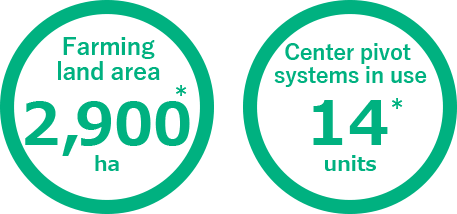
We purchased a tract of land covering approximately 2,900 hectares in the area of Al-Marashdah desert, Qena Governorate, southern Egypt, on the banks of the Nile River.
This area was a complete desert until we built access roads, a power grid, and an irrigating pipeline in a square grid pattern to install 14 center pivot irrigation systems.
We started running the systems in 2013 after the completion of the field test, taking advantage of abundant water resources lying underground from the Nile River.
*As of December 2019
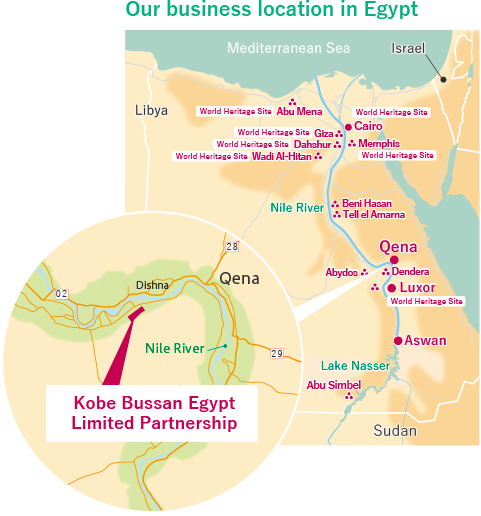
Why in Egypt?
Egypt is a country where agricultural practices began 7,000 years ago although it's desertified today. The harsh desert condition prevents weeds from growing much and allows farmers to use less pesticides and weed killers. Uncultivated for thousands of years, the desert remains in a natural state and uncontaminated by pesticide residues.
Qena in southern Egypt is assumed to have soil with sufficient subsoil water due to its location at the bend of the Nile River.
That is why we started the agricultual development there.
Blessing of the Nile
The Nile water not only flows in the river but also soaks into underground and accumulates like a huge water tank. The course of the river in Qena with a pocket like a navel shows the possession of abundant underground water and enables us to ensure lots of pristine groundwater from the Nile River. We use our experience and know-how to leverage the water, considering it as a blessed resource, not just groundwater.
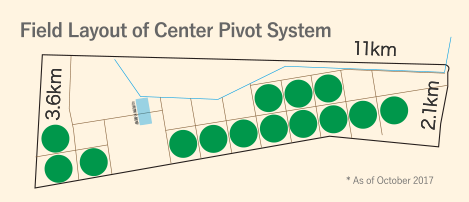
What is Center Pivot Irrigation?
The center pivot irrigation is a method to irrigate arid regions to cultivate crops there. Sprinklers rotate in the center of a circular farmland to spray the groundwater.
*Number of the irrigation systems currently in use:
14 systems
*Diameter of an irrigation circle: 800 meters
*Land area covered by a single center pivot system: Approx.50 hectares (equivalent to 10 Tokyo Domes)
The Innovation Turning Desert Land into Farmland
The center pivot irrigation pumps water from the ground and sprays it onto the field through a self-propelled pipeline, enabling large-scale cultivation in arid areas. To distribute water evenly, the system delivers more water to the edge of the round firmland than to the center.
Currently, Kobe Bussan Group operates a total of 14 center pivot irrigation systems in Egypt.

The center pivot irrigation pumps water from the ground and sprays it onto the field through a self-propelled pipeline, enabling large-scale cultivation in arid areas. To distribute water evenly, the system delivers more water to the edge of the round firmland than to the center.
Currently, Kobe Bussan Group operates a total of 14 center pivot irrigation systems in Egypt.
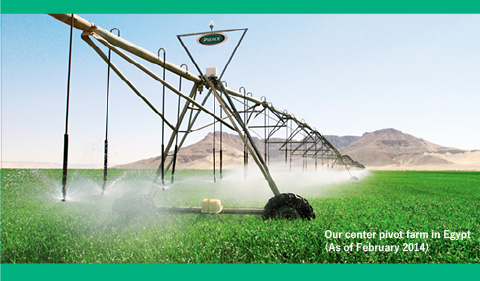
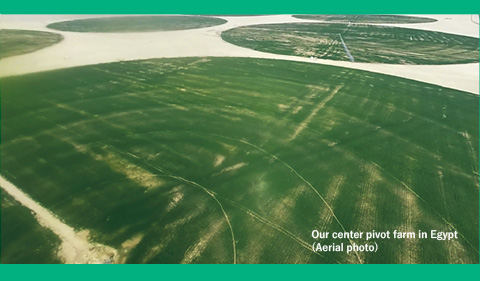
Wheat Harvesting & Our Future Vision
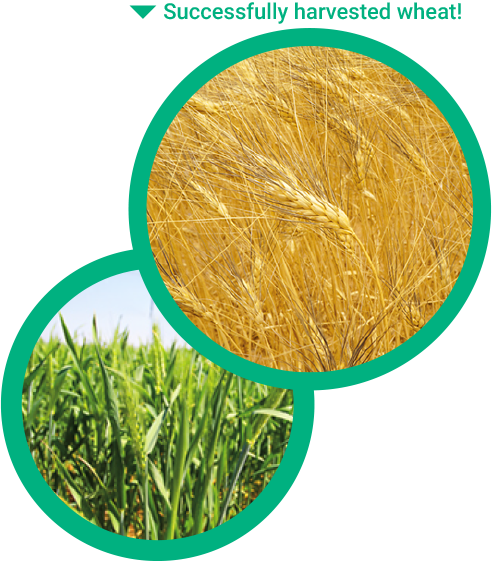
Wheat Harvesting & Our Future Vision
In the spring of 2014, we successfully harvested golden-brown wheat from the arid land that was once a vast barren desert.
In addition to wheat, we're experimenting with growing tomatoes, alfalfa, chamomile, lemongrass, basil, and other crops on our farm.
Through the agricultural projects in Egypt, we're engaged in overseas CSR activities, such as donating a portion of our farm-harvested wheat to food-insecure areas in Egypt and providing our technology to an agricultural school in the country
Sustainable Tourism
in Harmony with Nature:
Orchard with
Geothermal Energy
Kobe Bussan Group is actively developing an ecotourism business, including tourist fruit farms heated by geothermal energy (from a hot spring) to ensure better use of the beautiful natural and cultural resources of Japan.
Our goal is to build an ecotourism facility that satisfies both domestic and international guests as well as their families and friends and hopefully offers an opportunity to revitalize regional communities.
One of the Japan's Largest Tourist Farms & Orchards
In Mori-machi, Kayabe-gun, Hokkaido, Kobe Bussan Group is planning to build a large-scale greenhouse heated by geothermal energy (from a hot spring) as a tourist farm and orchard.
We set up an outdoor farm and a greenhouse in the vast land of approximately 40 hectares, where we grow mainly cherries, along with various berries such as haskap, a specialty blue honeysuckle in Hokkaido, as well as peaches and apples in an outdoor environment. In a greenhouse heated by geothermal energy, cherries can be harvested even in rainy weather.
We are currently making this plan to ensure that our future visitors will enjoy fresh-picked fruits in the magnificent nature of Hokkaido.
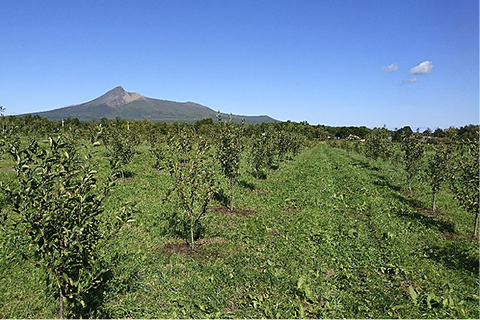
Outdoor cultivation
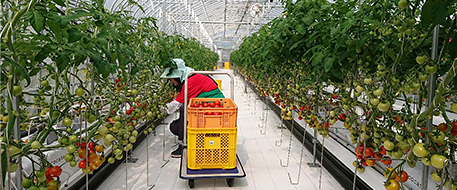
In recent years, we have started producing cherry tomatoes and medium-sized tomatoes by hydroponic culture in a greenhouse heated by geothermal energy.
Our greenhouse maintains a sanitary growing environment by covering the entire floor with a plastic sheeting film, equipped with an installation such as automatic irrigation equipment to enable the stable production.

In recent years, we have started producing cherry tomatoes and medium-sized tomatoes by hydroponic culture in a greenhouse heated by geothermal energy.
Our greenhouse maintains a sanitary growing environment by covering the entire floor with a plastic sheeting film, equipped with an installation such as automatic irrigation equipment to enable the stable production.
